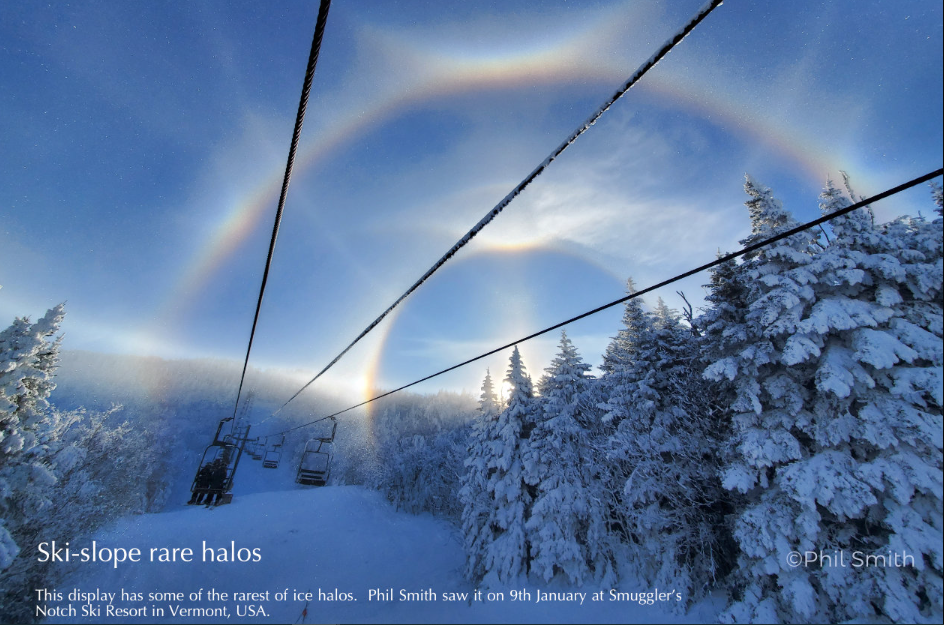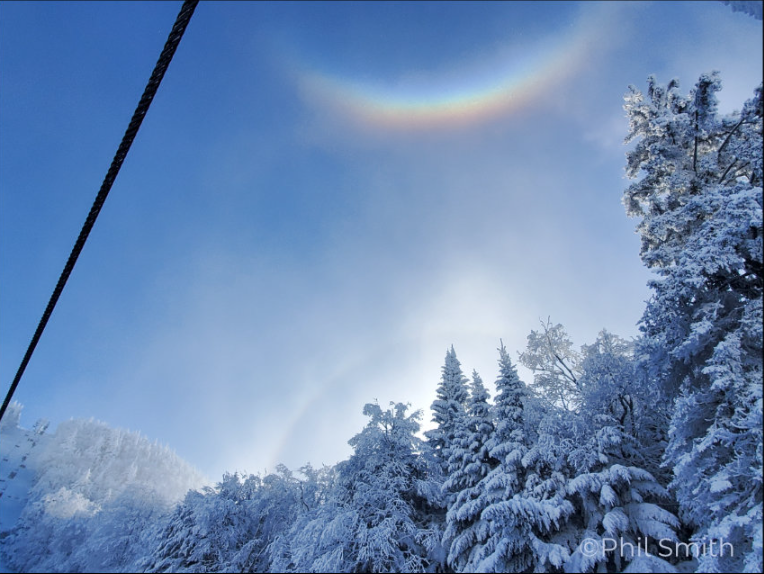Ski-slope rare halos - Kern Arc?
Ski-slope Rare Halos - Exploring the Enigmatic Kern Arc
When it comes to atmospheric optics, some phenomena are so rare and captivating that witnessing them becomes a privilege. One such phenomenon is the ski-slope rare halos, which were recently observed by Phil Smith on January 9th at Smuggler’s Notch Ski Resort in Vermont, USA. These halos are a spectacle of nature, displaying intricate patterns and colors that astound observers. In this article, we delve into one of the most notable features of these halos - the enigmatic Kern Arc.
The Kern Arc is an exceptionally rare halo that can be seen as a continuation of the colorful circumzenithal arc at the top. To witness the Kern Arc is a true marvel, as it forms a full circle around the zenith. Its presence adds an extra layer of beauty to an already mesmerizing display. Alongside the Kern Arc, other rare halos such as the faint Hastings arc make their appearance, making this particular event all the more remarkable. In comparison, the parry arc, located just above the upper tangent arc, is relatively common among these extraordinary phenomena.
To understand why these rare halos occur, we must explore the conditions necessary for their formation. These halos demand ice crystals that possess near-perfect optical properties. In the past, researchers had to travel to remote locations like the South Pole or Antarctica to study these elusive atmospheric displays. However, with advancements in technology and our understanding of ice crystal formation, we now have a more accessible method of observing these halos - by shining lamps at night near ski resorts.
The key to this accessibility lies in snow blowers used at ski resorts. Snow blowers operate by emitting small particles that act as nuclei for snow crystal growth. However, not all nuclei lead to the formation of snowflakes. Some escape into the air and can travel for miles. During their journey, these nuclei become the foundation for the growth of nearly perfect halo-forming ice crystals, such as simple plates and columnar prisms. The slow growth of these crystals on the drifting nuclei creates the ideal conditions for the formation of ski-slope rare halos.
When witnessing these extraordinary atmospheric phenomena, it is essential to pay attention to the circumzenithal arc. Observers should carefully examine whether it circles the zenith, indicating the presence of the famous Kern Arc. This meticulous observation allows us to fully appreciate the rarity and beauty of this particular halo formation.
In conclusion, ski-slope rare halos, with their intricate patterns and vibrant colors, are a sight to behold. The inclusion of the enigmatic Kern Arc, a full circle continuation of the circumzenithal arc, elevates these halos to a level of unparalleled beauty. Thanks to advancements in technology and our understanding of ice crystal formation, we no longer have to venture to remote locations to witness these captivating phenomena. By shining lamps near ski resorts, we can now observe these rare halos in all their glory. So, next time you find yourself at a ski resort on a clear winter night, take a moment to marvel at the ski-slope rare halos and appreciate the wonders of our atmosphere.

This display has some of the rarest of ice halos. Phil Smith saw it on 9th January at Smuggler’s Notch Ski Resort in Vermont, USA
The halo's are named are on the ray tracing simulation below. Click the labels for more information.
Most notable is the possible Kern arc which is a full circle continuation of the colourful circumzenithal arc at top. To see that one is the very rarest of privileges. A faint Hastings arc, further rarities. The parry arc just above the upper tangent arc is alomost commonplace in that company.
These rare halos demand ice crystals of near perfect optical perfection. Researchers used to travel to the South Pole and elsewhere in Antartica to study them. Now they shine lamps at night near ski resorts! Why?
Snow blowers. The bloers work by sending out small particles that act as nuclei for the growth of snow crystals. But some nuclei do not form snow. Instead they escape and can drift in the air for miles. During their drift, nearly perfect halo forming crystals - simple plates and columnar prismas - grow very slowly on them. When you see them, be sure to look carefully at the circumzenithal arc to check if it circles the zenith as the famous Kern.


Note: this article has been automatically converted from the old site and may not appear as intended. You can find the original article here.
Reference Atmospheric Optics
If you use any of the definitions, information, or data presented on Atmospheric Optics, please copy the link or reference below to properly credit us as the reference source. Thank you!
-
<a href="https://atoptics.co.uk/blog/ski-slope-rare-halos-kern-arc/">Ski-slope rare halos - Kern Arc?</a>
-
"Ski-slope rare halos - Kern Arc?". Atmospheric Optics. Accessed on November 24, 2024. https://atoptics.co.uk/blog/ski-slope-rare-halos-kern-arc/.
-
"Ski-slope rare halos - Kern Arc?". Atmospheric Optics, https://atoptics.co.uk/blog/ski-slope-rare-halos-kern-arc/. Accessed 24 November, 2024
-
Ski-slope rare halos - Kern Arc?. Atmospheric Optics. Retrieved from https://atoptics.co.uk/blog/ski-slope-rare-halos-kern-arc/.